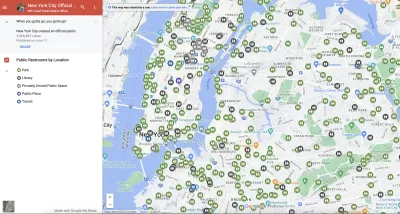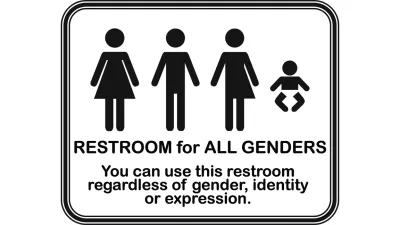New York City created a Google Maps layer to help residents and tourists alike more easily locate public restrooms.

Accessibility of public restrooms is an often overlooked yet critical aspect of the urban experience. Because if there is one universal truth, it is, “When you gotta go you gotta go.” According to a recent Bloomberg CityLab article, New York City recently acknowledged that truth when it built and released a Google Map layer that shows the city’s nearly 1,000 public toilets.
The new map, which Bloomberg reporter Sarah Holder reports was viewed 2.5 million times in the first few weeks of its launch, shows the location and operating hours of free restroom facilities in parks, plazas, libraries, and transit centers across the city. It is part of a broader city initiative called “Ur In Luck” to increase accessibility to public toilets, which also aims to create 46 new and renovate 36 existing park restrooms over the next five years. The plan includes an additional 14 self-cleaning public toilets as well.
Access to restrooms is one of humans’ most basic needs, which begs the question: Can a city be truly livable without it? With its current initiative, New York City seems to have acknowledged their importance. Will NYC serve as a role model for the many other U.S. cities that lack adequate restroom facilities?
FULL STORY: The Quest for a Public Bathroom in New York City

Montreal Mall to Become 6,000 Housing Units
Place Versailles will be transformed into a mixed-use complex over the next 25 years.

Planetizen Federal Action Tracker
A weekly monitor of how Trump’s orders and actions are impacting planners and planning in America.

DARTSpace Platform Streamlines Dallas TOD Application Process
The Dallas transit agency hopes a shorter permitting timeline will boost transit-oriented development around rail stations.

Study: 4% of Truckers Lack a Valid Commercial License
Over 56% of inspected trucks had other violations.

Chicago Judge Orders Thousands of Accessible Ped Signals
Only 3% of the city's crossing signals are currently accessible to blind pedestrians.

Philadelphia Swaps Car Lanes for Bikeways in Unanimous Vote
The project will transform one of the handful of streets responsible for 80% of the city’s major crashes.
Urban Design for Planners 1: Software Tools
This six-course series explores essential urban design concepts using open source software and equips planners with the tools they need to participate fully in the urban design process.
Planning for Universal Design
Learn the tools for implementing Universal Design in planning regulations.
City of Mt Shasta
City of Camden Redevelopment Agency
City of Astoria
Transportation Research & Education Center (TREC) at Portland State University
US High Speed Rail Association
City of Camden Redevelopment Agency
Municipality of Princeton (NJ)





























